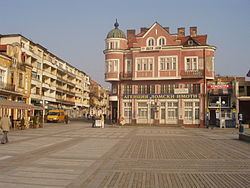Time zone EET (UTC+2) Website Official website Area 52.2 km² Area code 0971 | Postal Code 3600 Elevation 20 m Population 24,300 (31 Dec 2009) Local time Sunday 10:26 AM | |
 | ||
Weather 7°C, Wind W at 19 km/h, 74% Humidity | ||
Lom (Bulgarian: Лом) is a town in northwestern Bulgaria, part of Montana Province, situated on the right bank of the Danube, close to the estuary of the Lom River. It is the administrative centre of the eponymous Lom Municipality. The town is 162 km (101 mi) north of Sofia, 56 km (35 mi) southeast of Vidin, 50 km (31 mi) north of Montana and 42 km (26 mi) west of Kozloduy. It is the second most important Bulgarian port on the Danube after Rousse. As of December 2009, the town has a population of 24,300.
Contents
- Map of Lom Bulgaria
- Antiquity and Middle Ages
- Ottoman rule and Bulgarian National Revival
- Neighbourhoods
- Landmarks
- Religion
- Honour
- Municipality
- Twin towns Sister cities
- References
Map of Lom, Bulgaria
Antiquity and Middle Ages
Lom was founded by the Thracians under the name of Artanes in Antiquity. After them the Romans called the fortress and the town Almus, from where the name of the today's city and of the Lom River comes.
There are no reports proving that there existed a big settlement in the Middle Ages. It was not until Ottoman rule that it enlarged but for a long time it was under the shadow of the dominant towns of Vidin, Nikopol and Silistra. It is assumed that the Ottoman village was founded in 1695 by Kara Mustafa‹See TfD› and Murad Bey, who were defeated at Vienna in 1683 and who came here sailing rafts along the Danube.
Ottoman rule and Bulgarian National Revival
The name Lom Palanka was mentioned for the first time in 1704. The settlement then called Palanka stood between village and town in size and importance. In 1798 Lom suffered from brigand raids. With the development of shipping along the Danube after 1830, the importance of the town grew. The road to Sofia contributed to its progress and turned it into a main export port to Vienna (Austria). By 1869 there were 120 shops, 148 trade offices, 175 food shops, 34 coffee bars, six hotels and two mills. The town was centred on the old Kale (fortress), which was entered through three kapii (gates) — Vidinska, Belogradchishka, Sofiyska. The tradesmen from Lom offered goods at the biggest fairs in the region and beyond. In 1880 there were 7,500 inhabitants in the town.
Lom is proud of its traditions from the period of the Bulgarian National Revival. During the national revival, the first community centre in Bulgaria (1856) was founded in the town, the first women's society in the country was also established in 1858 and one of the first theatre performances took place in the town. Krastyu Pishurka, a noted educator, also worked in Lom.
Until the Second World War it was a major market town. After 1944 the industry developed — sugar factory, can factory, grain industry. It became a port for the northwestern part of Bulgaria.
Neighbourhoods
Neighbourhoods of Lom include:
Landmarks
Religion
The majority of the population of Lom is Christian Orthodox. The second biggest religious group is Protestantism-adventists and baptists.
Honour
Lom Peak on Livingston Island in the South Shetland Islands, Antarctica is named after Lom.
Municipality
The municipality of Lom consists of the following 9 villages plus the town of Lom itself, which is the administrative centre of the municipality.
Twin towns – Sister cities
Lom is twinned with:
